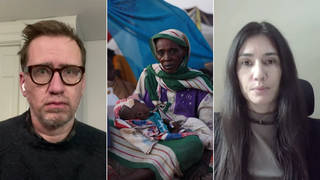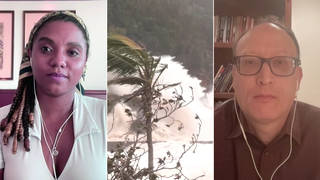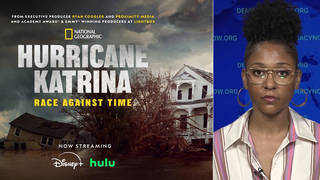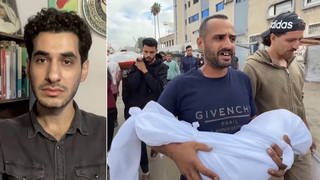
Topics
Questions still remain over how many people died after Hurricane Katrina as well as the whereabouts of all of the evacuees. The official death toll stands at about 1,300 but thousands of people are still reported missing. One newspaper reported the whereabouts of 6,600 people reported missing have not been determined. We speak with New Orleans evacuee Leah Hodges, who is still missing her brother, and Tina Susman, a Newsday reports the number of missing include over 1,300 children. [includes rush transcript]
Questions still remain over how many people died after Hurricane Katrina as well as the whereabouts of all of the evacuees. The official death toll stands at about 1,300 but thousands of people are still reported missing. Two weeks ago USA Today reported the whereabouts of 6,600 people reported missing have not been determined. And this past weekend Newsday reported the missing includes 1,300 children.
The reports are based on figures provided by two groups: The National Center for Missing and Exploited Children and the National Center For Missing Adults.
Officials with both groups say the numbers are so high in part because government record-keeping efforts haven’t caught up with Katrina survivors who were separated from their families during the evacuations. Hurricane shelters had no coordinated system for feeding evacuees” names, birth dates and other information into a national database.
- Leah Hodges, she testified in Washington at Wednesday’s hearing on Katrina. She is a former resident of New Orleans currently living in Atlanta. She is still missing her brother.
- Tina Susman, national correspondent for Newsday. She recently returned to New Orleans. Her article is “Looking for the Lost: The Search For Children Scattered by Katrina”
Transcript
AMY GOODMAN: Questions still remain over how many people have died after Hurricane Katrina, as well as the whereabouts of all of the evacuees. This is Congressmember Cynthia McKinney at the hearing.
REP. CYNTHIA McKINNEY: My question only requires a yes or no answer, and the question is: Do you have confidence in the number of dead that is being reported by the authorities?
WITNESS: No.
WITNESS: No.
REP. CYNTHIA McKINNEY: Thank you.
AMY GOODMAN: The official death toll stands at about 1,300, but thousands of people are still reported missing. Two weeks ago, USA Today reported the whereabouts of 6,600 people have not been determined. 6,600 people missing or dead. And this past weekend, Newsday reported the missing includes 1,300 children. The reports are based on figures provided by two groups: the National Center for Missing and Exploited Children and the National Center for Missing Adults. Officials with both groups say the numbers are so high, in part because government record-keeping efforts haven’t caught up with Katrina survivors who were separated from their families during the evacuations. Hurricane shelters had no coordinated system for feeding evacuees’ names, birthdates and other information into a national database.
To discuss this, we’re joined in Atlanta by Leah Hodges, yes, who testified in Washington at the hearing on Katrina, former resident of New Orleans, living in Atlanta right now. She is still missing her brother. We’re also joined in our New York studio by Tina Susman, who is a reporter with Newsday. She recently returned to New Orleans. Her article, “Looking for the Lost: The Search for Children Scattered by Katrina” appeared in Sunday’s newspaper. We welcome you both to Democracy Now!
TINA SUSMAN: Thank you.
AMY GOODMAN: Let’s begin with Leah. What do you know about your brother?
LEAH HODGES: I know that my brother has not been heard from or seen since the hurricane. We have examined lists from FEMA, Red Cross. He has not appeared on any list anywhere. I even inquired of FEMA to determine if, perhaps, he had applied for assistance. And FEMA is not authorized to give information on other applicants, but they did rule out his having applied for assistance with them. A company contacted me and my mother and other members of my family, seeking DNA samples. Well, it broke my heart, and I’m still holding out hope. I know this about my brother, from a child, I know that he was an excellent swimmer, but what I do not know is whether or not he could possibly be one of the shooting victims at the hands of military or police authorities during that catastrophe.
AMY GOODMAN: Now, when did you last talk to him, and when is the last time his whereabouts were known?
LEAH HODGES: The last time his whereabouts were known was just before the storm. He was in New Orleans. I had seen him fairly recently. There were times when he would visit with me, and he would stay overnight. My brother is an excellent musician. He is a drummer and a bassist, and he likes to play the blues on acoustic guitar. He does have a medical condition that is a matter of concern.
Also, my young nephew, little Lawrence Andrews and his sisters, they were with their maternal grandmother, and they were in a low-lying area of New Orleans East, an area where it has been reported that two schools containing over 2,000 people each were flooded upon the breakage of the levee system. The water rose so fast and with such great force, it is my understanding that the people were flushed out of those two buildings, and there were some drownings. So, my brother, Carl Hodges, and my nephew, little Lawrence Andrews, who is a straight-A student in school, have not been heard from since the storm. We have not located them on any missing lists.
My stepbrothers and sisters, Gwendolyn Smith, Lionel Andrew Smith, Jr. and my brother, Donald Smith — I saw him on a hospital vehicle entering the Causeway concentration camp at I-10 and Causeway in Jefferson Parish, and by the time I got to the area that was supposedly designated a medical area, he was already gone. I have not seen or heard from him. My cousin, Elvira Sellers and her children, Ernesta, Arthurine and Gregory Sellers, who I grew up with, very close. You know, we have many family members that have not appeared on any list, and we have not heard from them, but I have a — and I’m concerned about them all, but especially those with medical conditions. My brother, Carl Hodges, and my young nephew, little Lawrence Andrews.
AMY GOODMAN: Leah Hodges is speaking from Atlanta, where she has evacuated to. Tina Susman, we’re here in New York. You’re a Newsday reporter. After 9/11, I mean, the numbers, people were fixated on them. We would hear one day there are 3,600 people missing, and then it would go down 20, up 3, down 500. Everyone was fixated. It mattered so much, and the government every day, it seemed, almost, was updating us. What about these numbers?
TINA SUSMAN: Well, these numbers — I don’t think anybody is updating these numbers on a regular basis. I mean, just myself, trying to find any numbers, before I set out for this trip to New Orleans to work on the search for missing children, I spent two weeks on the phone, on the websites. That word “lists” which Miss Hodges mentioned, it kept coming up with me, as well. I scanned countless lists, and I discovered that if you looked at one list that was on the internet of missing names and then you compared it to another list, you wouldn’t find the same names on those lists. Utter confusion.
And I kept thinking to myself, you know, for me, here I am a journalist in New York, I have got 24-hour computer access. I can take my time looking for the stuff. Imagine what it must be like for a family member, for a parent, particularly for these people who for the most part have no computer access, most of them had no cell phones. How are they actually supposed to conduct this search? That’s why I finally just got on a plane and went down there, because I realized trying to get the information from a distance was virtually impossible, trying to get the accurate information.
One of the pieces of information I actually started out trying to find was simply the number of children who had ended up in foster care across the nation as a result of the hurricane. It took me two weeks to get a number for that. And even then, that number was based on reporting from only three states, even though I was told that every state was supposed to report to the federal government on a weekly basis how many children they had in foster care as a result of them showing up unaccompanied after Katrina. Trying to get the information was just — it was just an exercise in frustration. So, I just got on a plane, and I went down there and discovered what at least the National Center for Missing and Exploited Children is doing to try to find out at least what happened to the children who were still reported missing.
And it’s amazing how basic — what they have been reduced to, essentially, is the most basic gumshoe investigative work you can imagine. They literally, and I spent a day with them doing this, they literally get in their car, they take whatever shreds of information they have been able to glean from relatives, whoever has reported these people missing, they turn on their little talking GPS device in the car, and they start retracing the steps of the family members, which for the most part means just driving from one abandoned house to another.
AMY GOODMAN: You followed them?
TINA SUSMAN: I was actually in the car with them, and we spent, I think, six or seven hours that day following up on five cases. Just to give you an example of the kinds of things that they’re having to contend with, I mean, a lot of the children — first of all, the number of children officially still missing at that time, that was the end of November, is about 1,300. It’s a huge amount.
AMY GOODMAN: These are missing or dead? We don’t know?
TINA SUSMAN: We don’t know. They believe that the vast majority of them are safe somewhere, but because of all the chaos we heard about the evacuation efforts, because of the lack of infrastructure, because of the evacuees, the families who don’t have computers — they can’t send emails to their families. They can’t pick up a cell phone and call people, because the shelters had no system for registering who came in, who went out, and now because of the pending evacuation of people from hotel rooms across the country, you know, there’s no way, even if these children are safe, how are their relatives who have been flung across the country, often through no fault of their own, supposed to find each other.
AMY GOODMAN: Well, for one thing, it seems like the media could play an absolutely key role here. In the midst of the hurricane and the aftermath, you had the pictures going up. And you realize for family members who were forced out, they might not even have pictures right now. But, Leah Hodges, how important is this for the media, for people to be able to speak out and describe who their loved ones are and for kids and for adults to go on-air, to say who they’re looking for? And what about the role of the U.S. government here?
LEAH HODGES: The U.S. government, absolutely, and the news media, but particularly, especially, the U.S. government since they bear the brunt of responsibility for the mass dispersion and for the atrocities that happened to us, they have a serious, serious burden incumbent upon them to help locate missing family members, as well as to reunite families who have been dispersed. We are still in a state of emotional shock. We are still having horrible nightmares. It’s as if our hearts have been ripped into so many different directions, because our families are so far-flung and so widely dispersed. This — it’s just a horrible — another horrible, horrible nightmare that has arisen from this entire aftermath, horrible aftermath.
AMY GOODMAN: Clearly, the government has — does not want these numbers just — I mean, I think very much out there, it’s not in their favor. When you say something like 6,600 people, that is more than twice the number who died on 9/11. Now, again, this is missing and dead, but in the search that you went on for missing children, did any clues, any children, were they found?
TINA SUSMAN: We actually — yes, two children and their mother, that I focused on — actually, my main story — were found about — actually two days after we were searching for them. And I actually spoke to the mother, and the — you know, one of the things she told me during her evacuation from the Convention Center in New Orleans really illustrated just how these children got separated from their families. She had spent a week stranded in her apartment. When the water went down enough, she was able to get her children to the Convention Center. They were waiting to get on a bus, and when, finally, they were able to get onto that bus, she told me that a police officer came and took her two children — one is six, and one is a one-year-old — took them, and put them on the bus and tried to prevent her from getting on the bus. The idea was 'Well let's get the kids on the bus,’ which might sound okay, except that if the rest of the family is getting left behind and there’s no way for people to get them back together what really — really, what good does it do? That’s why we are in the mess we are in now.
Now, this lady would not take this. She fought, and she was able to get on the bus finally. If you speak to her on the phone, you will understand why. She clearly is not one to be pushed around. But she told me later, you know, I can’t — I dread to think what would have happened if I had not pushed my way and fought with that police officer. Now, to force a mother, a parent, anybody, to have to fight to stay with their family during this situation, that’s just not the way it should be done. And if you have spent time overseas dealing with international emergencies, which I did for many years, and you speak to aid groups like the International Rescue Committee, who specializes in this kind of management, one of the things they say is, 'keep the families together.' You always have to keep the families together, and if you separate them, make sure that the kids have name tags even if it means scrawling their names on their skin, which is actually what they have done in Pakistan since the earthquake.
AMY GOODMAN: Well, Tina Susman, this is part one of this discussion. I ask you if you can come back next week, because — and Leah Hodges — this is too important to leave here. We will continue our series on the aftermath of Katrina, more than three months after the hurricane. Tina Susman of Newsday; Leah Hodges, a New Orleans community leader and evacuee now in Atlanta.












Media Options